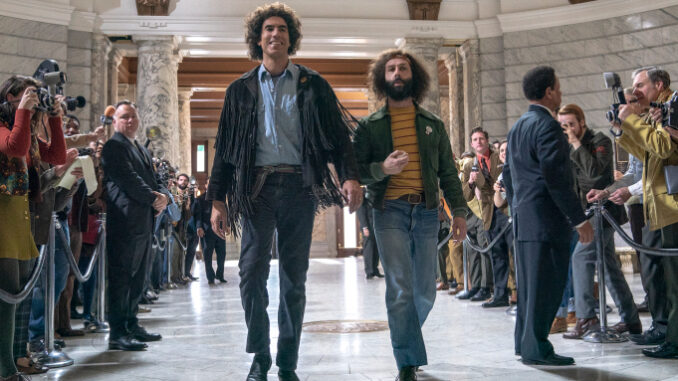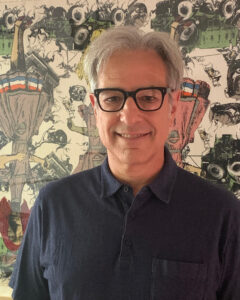
by Peter Tonguette
In 2007, when writer-director Aaron Sorkin turned in the first version of his script about the trial of the Chicago 7, few could have foreseen that 13 years would pass before the film began production. Even fewer could have anticipated that the film’s release would coincide with a moment of social tumult, civil unrest, and political divisiveness that bears comparison to the events shown onscreen.
“The Trial of the Chicago 7”—which will be available to stream on Netflix starting Friday—revolves around the federal government’s prosecution of a group of anti-Vietnam War activists who converged outside the 1968 Democratic National Convention in Chicago. Notoriously, protests in Grant Park became the site of violent clashes between activists and law enforcement. In the film, the trial—whose defendants included Abbie Hoffman (Sacha Baron Cohen), Tom Hayden (Eddie Redmayne), Bobby Seale (Yahya Abdul-Mateen II), and David Dellinger (John Carroll Lynch)—provides an entry point to flashbacks of the protests themselves (and flash-forwards to Hoffman puckishly recounting the whole affair). Joseph Gordon-Levitt plays prosecutor Richard Shultz, and Frank Langella, Judge Julius Hoffman.
“We hoped it would always be relevant and perhaps timely, no matter when it came out,” said picture editor Alan Baumgarten, ACE. “Aaron wrote the film as a dramatization of the events from the 1960s, but he didn’t want to tilt it into the world of the ’60s exclusively. His intention was always to make it more contemporary and relatable.”
Yet the film could never be more contemporary or relatable than it is when viewed in the fall of 2020—a fact not lost on the post-production team, who were busy putting the finishing touches on the edit just as the country found itself riveted by protests against racism and police brutality.
“The fact that it is coming out now, and we finish it this year with the events that have been taking place, we would have never imagined,” Baumgarten said.

For Baumgarten—whose previous credits include Jay Roach’s “Recount” (2008), for which he won a Primetime Emmy Award, and David O. Russell’s “American Hustle” (2013), for which he and co-editors Jay Cassidy, ACE, and Crispin Struthers, ACE, were nominated for Oscars—the film represents the continuation of a collaboration with Sorkin, who burnished a reputation as one of Hollywood’s most gifted screenwriters on the strength of films including “A Few Good Men” (1992), “Charlie Wilson’s War” (2007), and “The Social Network” (2010).
In 2017, when he made his directorial debut with “Molly’s Game,” Sorkin first turned to editors Elliot Graham, ACE, and Josh Schaeffer, ACE. When Graham had to depart the project due to another commitment, Baumgaren’s name was proposed to step in where his predecessor left off. He got the gig.
“Elliot crafted the beginning of the movie, the opening montage, which was fantastic and set a tone for ‘Molly’s Game,’” Baumgarten said. “When I came in, I just hit my stride with Josh, and we stayed on all the way to the end.”
Baumgarten describes the three editors of “Molly’s Game” as good-naturedly jockeying for the job of editing Sorkin’s next movie. “It was a joke between us,” Baumgarten said. “I had gotten the lucky straw in the sense that it just worked out. Good fortune played a role in that.” When budgetary issues prevented “The Trial of the Chicago 7” from starting production as planned in the fall of 2018, Baumgarten remained onboard until shooting was ready to commence the following year. “At that point, it was something I was just going to make sure I was available—whenever it happened,” he said.
Before beginning work on the project, Baumgarten hit the books to research the events depicted in the film. “I got to know more facts and details about the story and the events, and, of course, Aaron draws on all of that and uses some of the court transcripts,” he said. “But it is a dramatization, and he weaves in a lot of fictional elements. I also let go of all of that research. We’re not making a documentary.”
In fact, the film is as editorially inventive as it is socially resonant: Early on, the film hopscotches between several protagonists each heard mid-conversation; one character’s sentence is completed by the next.
“Aaron writes in a very specific way that is hugely fun to cut,” Baumgarten said. “Sometimes the scenes are literally woven together—dialogue is going from one scene to another scene.” Flashbacks are embedded in the trial scenes. For example, when an attorney is questioning an administrative employee in the office of Mayor Richard J. Daley, Baumgarten cuts to flashbacks of a meeting between several defendants and the employee. “It’s clearly a case where we’re hearing the story from multiple points of view,” he said.
In the scenes surrounding the trial, Baumgarten often opted for a leisurely, sometimes stately pace, letting shots linger on characters for just a beat longer than we sometimes expect.
“Tom Hayden and Abbie Hoffman are clearly shown from early on in the film to have different points of views—different tactics, different approaches,” Baumgarten said. “Sometimes they go at it in heated dialogue, and then other times it’s just a remark or two, and a look between them. You can feel the tension through just a visual expression.”
On the other hand, when the film backtracks to the protest scenes, Baumgarten favored a kinetic, fast-paced style that interwove newly shot footage with archival material, including shots borrowed from Haskell Wexler’s classic 1969 film “Medium Cool,” which was shot during the protests outside the Democratic National Convention that year. The goal, Baumgarten said, was to seamlessly transition from new to old footage.
“You find a way to blend it, or to carry from your material to that material and back, in a way that isn’t necessarily jarring,” he said. “It pulls you in. It validates things. It gives you an authenticity.”
In both “Molly’s Game” and “The Trial of the Chicago 7,” Sorkin preferred to let Baumgarten work independently during production.
“I’m in sync very much with his sensibilities because I’d worked with him once before, and I know generally the performance and the takes he’s looking for,” Baumgarten said. When it came time to view the editor’s cut, Sorkin not only looked at it—he listened to it very carefully. “Aaron actually hears the dialogue in his head, and sees the film in his head, before he even enters the editing room,” Baumgarten said. “He knows the rhythm and the cadence he’s looking for, and I follow the dialogue in the script very closely when I’m putting the film together.”
When Sorkin made suggestions, the director was happy to leave Baumgarten and his team—including first assistant editor Christine Kim, second assistant editor Brandon Marchionda, and editorial production assistant Kaitlyn Ali—to figure out solutions. “As a writer, he definitely understands the editing process, but he doesn’t feel the need to be there all the time,” Baumgarten said. “He’s not somebody who wants to sit over my shoulder.”
Baumgarten and Sorkin had completed the 10-week director’s cut just as coronavirus pandemic-prompted shutdowns were instituted throughout the industry. “We were about to screen the movie for the studio, which was Paramount,” Baumgarten said. “The day before our screening was about to happen was when everybody stopped coming to work.” Instead, the cut was posted on PIX, and the editor and director received notes on Zoom calls.
The rest of the crew was scattered. Music consultant Carlton Kaller worked from his home base in Hawaii, and composer Daniel Pemberton was standing by in London. “With Carl and Daniel, we ended up doing the music long-distance, basically,” Baumgarten said. The film was rerecorded at Warner Bros., where capacity was limited to a certain number of people on the mixing stage. “If another person showed up when Aaron would come for a playback or a review, one person would have to step off the stage,” Baumgarten said.
One casualty of cutting the film during the pandemic: test screenings. “That actually suited Aaron OK—he didn’t mind not having to expose the film to a lot of people,” Baumgarten said. “The script was something that Aaron had been working on for many years. . . . This is a project that was very tight in the sense that we weren’t looking to make a lot of changes anyway.”
Call it a film whose time has come: In the end, “The Trial of the Chicago 7” is not only a fascinating history lesson but a genuine parable for 2020. “As we were literally finishing the film,” Baumgarten said, “the protests and civil unrest that was taking hold in cities all across this country were chilling and so real and specific to similarities that we had in the film.”



